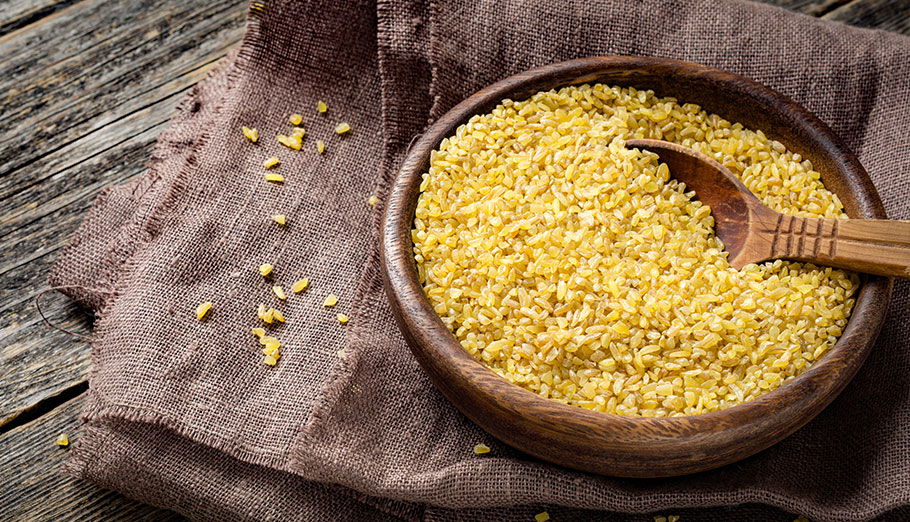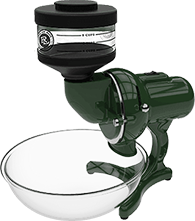Bulgur

Overview (Has Gluten)
Bulgur is often confused with cracked wheat, however, they are different. Bulgur is made from whole wheat that is parboiled (soaked, steamed and dried, usually by the sun) and de-branned. Cracked wheat, on the other hand, is made from crushed wheat grains that are not parboiled.
Bulgur production is a process that originated in the Mediterranean and has been an integral part of Middle Eastern cuisine for thousands of years. Bulgur may be considered man’s first “processed food,” referring to the process of soaking it in water, then drying it in the sun.
Bulgur processing inactivates enzymes and microorganisms, resulting in a cereal food that resists mold contamination and insect attacks, enabling storage for long periods of time.
Ancient preparation techniques are still used in small eastern Mediterranean villages. The first step is to boil wheat in huge pots, sometimes for days. Next, the grain is spread out on a flat surface (often a rooftop) to dry in the sun. Finally, the grain is cracked into coarse pieces and sorted by size for various uses.
In ancient times, bulgur was an excellent food source. The same holds true today.
Nutrition
This whole-grain staple is an inexpensive source of low-fat protein and low in calories. Bulgur is a great option for people following vegetarian and vegan eating plans.
Note: Weight of a cup (or partial cup) of flour varies depending upon whether it is lightly sprinkled into a measuring cup or compacted. Most recipe measurements are based on sifted flour as a way to arrive at a more uniform measurement.
Health Benefits of Bulgur Wheat
As with all whole grains, Bulgur is rich in dietary fiber, protein, minerals, and vitamins. These components, found in the germ and bran promote healthy gut bacteria, promote heart health, and help promote a healthy metabolism.
Gluten Content & Allergen Information
Bulgur does contain gluten, so those with Celiac disease or gluten intolerance should steer clear of bulgur flour. Wheat, rye, and barley are the grains that contain gluten, and bulgur is wheat grain that has been soaked in water, dried and broken down to remove the bran. People allergic to gluten may experience hives, an upset stomach, or even tongue swelling and airway constriction that could cause asphyxiation.
Nutrition Facts
| Serving Size | 1/4 Cup (dry) 40g |
| Calories | 140 |
| Total Fat 6g | 1% |
| Cholesterol 0mg | 0% |
| Sodium 4mg | 1% |
| Carbohydrates 30g | 10% |
| Dietary Fiber 7g | 24% |
| Total Sugars 0g |
| Protein 5g |
| Vitamin D 0mcg | 0% |
| Calcium 20mg | 2% |
| Iron 1mg | 6% |
| Potassium 184mg | 4% |
* The % Daily Value (DV) tells you how much a nutrient in a serving of food contributes to a daily diet. 2,000 calories a day is used for general nutrition advice.
Diet Compatibility
Paleo Diet
The Paleo Diet seeks to emulate the hunter-gatherer diet of our stone-age ancestors. The emphasis is on wild plants and meats similar to what ancient man would have consumed. As such, dairy products, refined sugar and processed oils are off limits. While many Paleo Diet followers also avoid grains, there is ample archaeological evidence to show that grains were part of Paleolithic era man’s diet.
Compatibility with Bulgur Flour:
Not Compatible

Mediterranean Diet
This diet seeks to emulate the diets of those living along the Mediterranean coast, with an emphasis on fresh fruits and vegetables, seafood/fish at least twice a week, limited servings of poultry, and only occasional sweets and red meat.
Compatibility with Bulgur Flour:
Compatible

Gluten-Free Diet
As the name suggests, the gluten-free diet eliminates all foods with gluten. Although most of those on a gluten-free diet are on it out of necessity—either due to severe wheat allergies or Celiac disease—many have embraced a gluten-free diet as being healthier.
Compatibility with Blugur Flour:
Not Compatible

Macrobiotic Diet
Although there are many versions of macrobiotic diets, the common thread is that they emphasize natural, whole foods, grown locally and organically. Whole grains, vegetables, legumes, fruits, seeds and nuts, and occasional seafood are all integral to the diet. Red meats, dairy, poultry, eggs and processed foods are off the menu.
Compatibility with Bulgur Flour:
Compatible

Acid Alkaline Diet
This diet aims to restore the slightly alkaline state of the body, which is believed to be ideal. By focusing on a diet high in vegetables, fruits, sprouted grains, lentils, almonds and soy products, the goal is to have a balance of 80% alkalizing foods and 20% acid forming foods.
Compatibility with Bulgur Flour:
Compatible – Bulgur Flour is considered to be neutral acidity

Low-Carb Diet
As the name suggests, this diet focuses on reducing carbohydrates in the diet to lose weight. The theory is that by staying away from high-carb foods like pasta and bread and eating low carb, high fiber vegetables and fruits instead, your body will go into ketosis and you will lose weight. This diet is sometimes referred to as a ketogenic diet.
Compatibility with Bulgur Flour:
Not Compatible

Atkins Diet
The Atkins Diet is a historically popular low carb diet, instructing dieters not to worry about their calories but to monitor and minimize their intake of sugar and carbohydrates. According to Dr. Atkins, depriving the body of its primary energy sources causes the body to burn fat.
Compatibility with Bulgur Flour:
Not Compatible

“We love the mill! We use it every day for things from bread, to pastry and it is phenomenal. The biggest selling point for me was the fineness since that would mean we can really do some great pastry with it in addition to bread. It definitely has been great!"
BEN FROM NORTH CAROLINA

